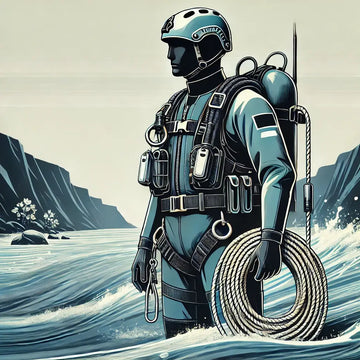Water rescue operations demand precision, speed, and the right equipment. Whether it’s a swimmer in distress, a boating accident, or a flood scenario, having the proper water rescue gear can mean the difference between life and death. In this blog, we’ll explore the essential water rescue tools, their applications, and why they are indispensable for rescuers operating in aquatic environments.
Why Water Rescue Gear Matters
Water rescues often involve:
-
Unpredictable Conditions: Strong currents, waves, or sudden weather changes.
-
Limited Time: A victim’s survival depends on rapid response.
-
Physical Challenges: Cold water, low visibility, and underwater hazards.
Without specialized gear, rescuers face increased risks, and their ability to save lives diminishes. Investing in high-quality, durable, and versatile water rescue equipment is essential for safety and efficiency.
Essential Water Rescue Gear
1. Personal Flotation Devices (PFDs)
-
Features: High-buoyancy, adjustable straps, and quick-release harnesses.
-
Applications: Keeps rescuers and victims afloat while allowing freedom of movement.
-
Tip: Choose PFDs specifically designed for rescue operations with extra features like attachment points for tools.
2. Throw Bags
-
Features: Contains a floating rope made of durable materials like polypropylene.
-
Applications: Quickly deployable for reaching victims from a distance.
-
Tip: Look for throw bags with reflective materials for visibility in low-light conditions.
3. Rescue Boards
-
Features: Lightweight, durable, and stable even in rough waters.
-
Applications: Ideal for quickly reaching and stabilizing victims.
-
Tip: Inflatable rescue boards are easier to transport and deploy in emergency scenarios.
4. Rescue Helmets
-
Features: Impact-resistant, water-draining, and lightweight.
-
Applications: Protects rescuers from head injuries caused by debris or rocky environments.
-
Tip: Ensure the helmet fits snugly and meets water safety standards.
5. Dry Suits and Wetsuits
-
Features: Insulated and waterproof to protect against hypothermia.
-
Applications: Essential for rescues in cold or prolonged water exposure.
-
Tip: A dry suit is preferable for cold water, while a wetsuit is ideal for warmer conditions.
6. Rescue Sleds
-
Features: Designed for towing victims to safety, often attached to jet skis.
-
Applications: Commonly used in ocean and flood rescues.
-
Tip: Look for sleds with handles and padding for victim comfort.
7. Waterproof Communication Devices
-
Features: Radios with waterproof casings and clear audio in wet conditions.
-
Applications: Enables coordination between rescue teams.
-
Tip: Choose devices with long battery life and secure mounting options.
8. Rescue Ropes and Carabiners
-
Features: Floating, high-strength ropes paired with corrosion-resistant carabiners.
-
Applications: Used for anchoring, towing, and securing rescues.
-
Tip: Inspect ropes and carabiners regularly for wear and tear.
9. First Aid Kits
-
Features: Waterproof kits with supplies for treating hypothermia, cuts, and abrasions.
-
Applications: Provides immediate care for victims post-rescue.
-
Tip: Include items like thermal blankets and CPR masks for comprehensive care.
Advanced Water Rescue Gear
For specialized operations, advanced equipment can enhance capabilities:
-
Sonar Devices: For locating submerged objects or victims.
-
Drones: Equipped with cameras for scouting and assessing rescue sites.
-
Inflatable Rescue Boats (IRBs): Highly maneuverable boats for team operations.
Training: A Vital Component
Gear alone is not enough. Rescuers must undergo rigorous training to:
-
Master the use of water rescue tools.
-
Build physical endurance and water confidence.
-
Coordinate effectively with team members during high-stress scenarios.
Maintenance Tips for Water Rescue Gear
To ensure reliability, regular maintenance is crucial:
-
Rinse After Use: Remove salt, sand, and contaminants.
-
Dry Properly: Store gear in a dry, ventilated area to prevent mold and mildew.
-
Inspect Frequently: Check for signs of wear, especially on ropes and PFDs.
-
Replace Worn Items: Retire equipment that no longer meets safety standards.
The Future of Water Rescue Gear
As technology advances, water rescue gear is becoming more sophisticated. Innovations such as AI-powered drones, enhanced thermal imaging, and lightweight yet durable materials are shaping the future of aquatic rescues. These advancements promise to improve safety, efficiency, and success rates in even the most challenging conditions.
Conclusion
Water rescue gear is the cornerstone of safe and effective aquatic emergency response. From basic tools like PFDs and throw bags to advanced technologies like sonar devices and drones, every piece of equipment plays a critical role. By investing in high-quality gear, maintaining it properly, and prioritizing training, rescue teams can operate with confidence and save lives when it matters most.
For more insights on water rescue equipment and best practices, stay tuned to our blog. If you have questions or need recommendations, feel free to reach out!





